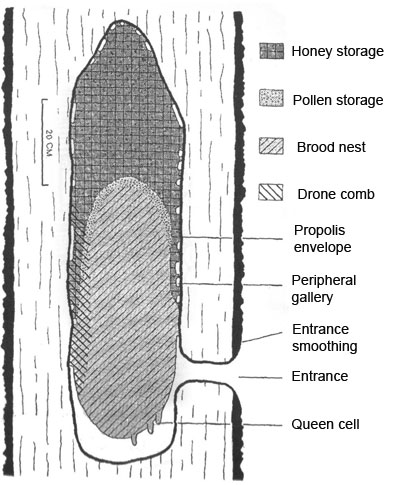Apis mellifera is a cavity nester. Understanding the basic nest ecology has led to an effective and efficient, man-made hive . the Langstroth hive. The natural or feral nest (and beekeeper hive) has these five features:
- Sheltered, darkened enclosure
- Small, defensible entrance
- Size of adequate volume
- Hexagonal beeswax cells molded into parallel comb separated by bee space
- Separation of brood (a central sphere) and food (to the top and sides).
A tree cavity is a common nest site in the temperate area. Maple, oak and ash trees are commonly available but bees will select virtually any tree if a suitable cavity is present. Knotholes are the most common types of opening but cracks or other openings can also be used. Bees prefer openings high in a tree, but will nest wherever the cavity is available. Most tree nests are in live trees; the cavities are the result of fungal action on the inner wood.
Since beeswax comb is fragile, shelter is important for successful winter survival of a bee colony. Occasionally a bee colony will build in an exposed location but such colonies seldom survive the winter in temperate climates. Tropical bees survive with such nests more frequently. A darkened enclosure is needed for efficient wax secretion . worker wax glands secrete more wax and bees build more comb in darker sites compared to bees exposed to light.
Honey bees search for suitable cavities for their nest. Usually the searching is done by scout bees from a swarm. The European bees seldom move very far from the original homesite. From numerous studies their nest selection criteria involve:
- Volume . bees prefer 40 liters (range 20 to 100 liters). Tropical bees prefer smaller cavities and will nest in the open more readily.
- Height from ground . bees seem to prefer higher sites than those at ground level or close to the ground. Usually 3 meters (9 feet) is ideal.
- Exposure . sites in the open exposed to wind or full sun are less preferred.
- Entrance size & position . bees definitely prefer smaller entrance holes, openings at the bottom of the cavity and southward facing exposures.
- Cavity quality . bees prefer dry, unoccupied sites. They are attracted to smell of previous bee occupancy.

When scout bees search for a new homesite, they enter potential cavities and walk inside to measure dimensions. Because most cavities are in trees, the usual cavity is a tall cylinder. Once a homesite is selected, the swarm moves in. They may use propolis to smooth the entrance and inner wall areas of their nest and may reduce the size of the entry area with propolis. Some bee races such as Caucasians use extensive amounts of propolis, almost sealing the entrance area. Most nests have a single entrance.
Worker bees manufacture the only necessary nest material – beeswax. The beeswax is molded into parallel beeswax sheets termed combs. Most of the comb consists of worker cells. The cells are six-sided (hexagonal) and have a three-part bottom pyramid shape. Cells are horizontal facing both directions from a central midrib that provides important comb strength. The cells slope slightly upward and are planed to minimum thickness with a rim of extra wax at the top of the cell walls for ease in walking.
The hexagonal cells are of two sizes – worker cells are used to rear worker bees and for storage of honey and pollen. They average about five cells per linear inch. Bees also construct some drone cells in their comb. Drone cells average about four per linear inch; they are larger than worker cells but are still six-sided and otherwise similar to worker cells. Drone cells are used to raise drones and can be used for honey storage. When in a feral nest, bees build mostly worker cells and only about 15% drone-size cells.
In the natural nest, bees build several parallel combs at one time. As the colony expands, additional combs are added. When building their comb, bees adhere to a basic principle in spacing; they leave approximately 1 cm or 3/8 of an inch (the height of a bee) between combs. We call this space “bee space.” The comb is suspended from the top of the nesting cavity. Spaces less than 3/8″ are filled with propolis. If the space is larger than 3/8″, the bees will attempt to fill the space with comb.
In the sheltered, darkened cavity, the bees separate the area where they store their food and the area where they rear their brood (brood = egg, larval and pupal stages of bees). The brood is reared in the lower portion of the beeswax comb in a compact, spherical-shaped section because of the temperature requirements of the growing larvae. (Immature larvae need a temperature of 90-95° F or 32-36°C for optimal development.) Honey (stored as food) is above and to the sides of this central brood-rearing area.
Pollen, needed to feed the larvae, is stored in empty cells in the brood area and immediately to the outside of the active brood-rearing area. This central sphere of brood expands or contracts depending on the time of the season.
Back to Basic Bee Biology for Beekeepers table of contents
Source:
The above text is taken from The Mid-Atlantic Apiculture Research & Extension Consortium, Basic Bee Biology for Beekeepers; Fact Sheet,MAAREC Publication 1.4 March 2004.You can download this factsheet and others at the MAAREC website
